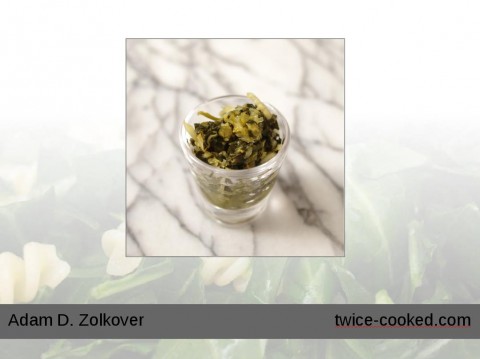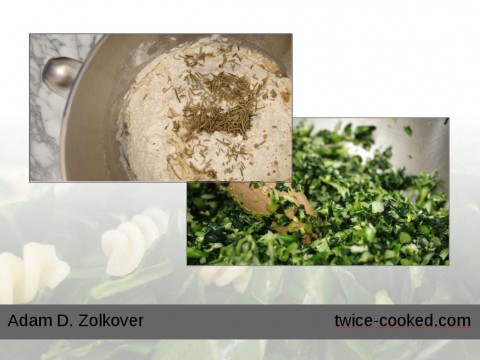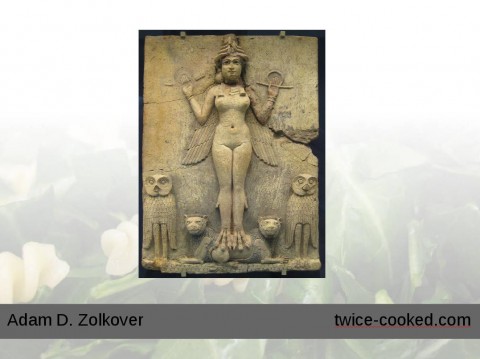What follows is the text of my talk at Philadelphia’s Science on Tap about fermentation. I’d like to thank all the Science on Tap folks — and especially Anna Dhody of the Mütter Museum — for inviting me to do something that turned out to be a huge amount of fun. And educational — for me.
Before we start, here is what you need to know about me. Though this is indeed Science on Tap, and though I was indeed invited here by the College of Physicians, I am neither a scientist nor an M.D. I am a food blogger, a folklorist, a historian, and — if anything — a fermentation enthusiast. This means that what I am interested in is people — how people use fermentation, how they have used it in the past, and how it works as a technology that improves quality of life, and the flavor and longevity of whatever it is folks are eating.
Fermentation is a bit of a popular topic right now. Alternet, the online indie reporting outfit and sometime light-news rag, called it their number one top food trend of 2013. In December of last year, they wrote:
Instead of telling themselves that bacteria and yeasts are creepy and gross, Americans are increasingly trying to culture these microbes in their kitchens by making homemade yogurt, kombucha, or sourdough bread. Or, for the less adventurous, buying ready-made fermented products in the store.
And they’re right. I was at a Whole Foods not a month ago and discovered one fellow camped out among the aisles, passing out free samples of fruit kvass. I’m surprised you can do this, I told him. Isn’t kvass a little bit alcoholic? It’s got live, active cultures! he responded, as if that were answer enough.
Now that was Whole Foods, not Acme. But I happen to know that Acme carries kimchi in its refrigerator aisle, and I could swear that I’ve seen skyr at the Superfresh. And when the Food Network’s website (how much more mainstream can you get?) has not one recipe, but two for lacto-fermented dill pickles — and one for pickled beets — it might be enough to surmise that we’re riding high on a wave of pickling popularity.
And that’s not even counting all the excellent and adventurous pickling blogs out there. Like Philadelphia’s own Phickle.com — run by Amanda Feifer — which offers fermentation guidance for everything from nato and miso, to kefir, to cheese.
Like I said, I’m no scientist. But the science of fermentation is actually pretty interesting. In broad strokes, it’s a process in which most cells engage in the absence of oxygen to convert sugars into energy. If you want to get technical, we could say that it is:
a process that is important in anaerobic conditions when there is no oxidative phosphorylation to maintain the production of ATP (Adenosine triphosphate) by glycolysis. During fermentation pyruvate is metabolised to various different compounds. Homolactic fermentation is the production of lactic acid from pyruvate; alcoholic fermentation is the conversion of pyruvate into ethanol and carbon dioxide; and heterolactic fermentation is the production of lactic acid as well as other acids and alcohols.
But that may be too technical. For our purposes — in terms of thinking about food, and especially cultured dairy and pickled vegetables — what we’re talking about amounts to a kind of controlled rot. Hungry microbes — certain kinds of beneficial bacteria like lactobacillus, and common household yeasts — pre-eat our food. They consume the sugars in vegetables and milk, and poop out lactic acid, or carbon dioxide, or alcohol. In the case of lactic acid fermentation, the bacterial byproduct quickly lowers the pH of the environment in which it is contained, stunting the growth of competing bacteria like e. coli or clostridium botulinum, and allowing our microbial heroes to thrive and feast.
We call this preservation because the microbes doing the feasting leave behind leftovers that remain edible and wholesome for humans for much longer than the natural life of fresh produce, and because their presence impedes the growth of other microbes that are likely to make us ill or kill us. But really, we’re talking about a healthful form of decay. Just think about the texture and color of sauerkraut, and I think you’ll see my point.
In any case, this form of controlled rot — this fermentation — happens all the time, whether we do anything to facilitate it or not. Every piece of fruit and every vegetable we put in our mouths is a teeming ecosystem of bacteria and yeast, competing to get the best of the nutrition available in its environment. What we do when we make pickles, or beer, or wine, or cheese is change the environment, and sometimes inoculate it with new microbes, in order to make the process of fermentation work to our advantage.
And so we brine cucumbers or mix shredded cabbage with salt — because it’s advantageous to the lactic-acid producing bacteria. And so we give bread yeasts lots of sugar and starch and warmth — because it kickstarts their growth. And so we boil the juice of grapes or barley and then inoculate those pasteurized solutions with our own yeast — because that way we know that the end result will be both delicious and safe to drink.
And this turns out to be an extraordinarily valuable set of practices. Much more valuable, I think, than most people know. In effect, we have over the millennia domesticated a whole subset of our microbial friends and neighbors. And in no small part, the return on all that work is civilization as we know it.
Dramatic, much? Sure. But to see what I’m talking about, you need only consider The Epic of Gilgamesh.
So The Epic of Gilgamesh is somewhere around 4,000 years old. It’s among the oldest pieces of literature that we still have, and it comes from Mesopotamia, in what is now southern Iraq. And if you know anything at all about it, what you probably know is that it’s about this god-king of Uruk — Gilgamesh — and his wild-man buddy — Enkidu — and their adventures killing stuff. They end up on the wrong side of the goddess Ishtar, Enkidu dies, and then Gilgamesh spends the rest of the epic depressed, wandering in the wilderness and learning that he can never have immortality in fact, just immortality in the form of legacy.
Before any of that can happen, though, they have to get Enkidu out of the wilderness (where he lives with a herd of gazelles) and into civilization. This involves sex. Lots of sex. Six straight days of sex, in fact, with the harlot Shamhat.
But that’s not all. The poem tells us that when with her delights Enkidu was finally sated, there were several more steps necessary before he was ready for the big city.
Bread they set before him,
ale they set before him,
Enkidu ate not the bread, but looked askance.How to eat bread Enkidu knew not,
how to drink ale he had never been shown.The harlot opened her mouth,
saying to Enkidu:
‘Eat the bread, Enkidu, essential to life,
drink the ale, the lot of the land!’Enkidu ate the bread until he was sated,
he drank the ale, a full seven goblets.
His mood became free, he started to sing,
his heart grew merry, his face lit up.
If, like me, you’re interested in the confluence of fermentation and history and people, this is a particularly good bit of the poem to know. Without bread and ale, Enkidu is definitely not civilized. But with it — after seven beers, at least — he’s doing distinctly civilized things: singing, and being merry, and acting in ways that are only appropriate when you have community with other human beings.
But his drunkenness isn’t what’s at issue. The bread and the ale themselves are. Bread and ale are markers of civilization in this 4,000 year old text because they are the products of basically industrial processes. Growing the barley to make ale and the wheat to make bread doesn’t make sense in a vacuum. You can cultivate them, but by themselves they aren’t really edible.
What you need to make them edible is fermentation. You need little wild yeasties bubbling up, spewing out alcohol and carbon dioxide, and pre-eating your food. Without that, you’ve got flour at best. With it, you’ve got a thing that’s essential to life, and the lot of the land.
What fermentation does in this case is allow people to grow foods that can be stored for long periods of time without refrigeration. It allows for things like grain silos. It’s sort of like just add water. But in this case, it’s just add yeast. The people of Uruk, or of Çatal Höyük, or of wherever other ancient city could live sedentary lives behind fortified walls — rather than hunting and gathering and following their food sources wherever they happened to be plentiful — because the use of fermentation as a technology allowed them the luxury of harvesting a crop once or twice a year, then storing it until the offseason when they could convert it into an edible form, making it a bulwark against starvation.
In one version of the epic, Shiduri — herself a tavern-keeper — tells a grieving Gilgamesh:
Let your belly be full,
enjoy yourself always by day and by night!
Make merry each day,
dance and play day and night!Let your clothes be clean,
let your head be washed, may you bathe in water!
Gaze on the child who holds your hand,
let your wife enjoy your repeated embrace!
But another ancient Middle Eastern text — one from somewhat later — has a better version of the same speech. From Ecclesiastes, in the Bible:
Go, eat your bread with enjoyment, and drink your wine with a merry heart … Let your garments always be white; do not let oil be lacking on your head. Enjoy life with the wife whom you love, all the days of your vain life that are given you under the sun.
It is no accident, I think, that both here and in The Epic of Gilgamesh it is fermented food and fermented drink that make a merry heart. And it is no accident that in both, they are necessities on par with letting your wife enjoy your repeated embrace.
Fermentation is important.
But enough of that. If fermentation as a human technology is essential to the idea of what it means to stay put, it is essential, too, to what it means to be on the move. And if it’s important in ancient Mesopotamia, it’s all the more so shipboard, if you’re a mariner in the eighteenth century.
Here, in what sometimes gets referred to as the Golden Age of Sail, fermented foods weren’t just about longevity and preservation, they’re about food as medicine. If you know one thing about what life was like at sea before refrigeration, that one thing is probably that the great scourge of seamen and the disease most feared by the officers of seagoing vessels was scurvy.
We now know that scurvy is basically a vitamin C deficiency. According to one source, it produces patients who present with low-grade inflammation, fatigue, limping, gum bleeding, or swollen extremities. And though cases of it do still exist — even in the twenty-first century United States — it looks so much like other disorders — vascultitis, rheumatic disorders, etc — that it tends not to get diagnosed, and we tend to think of it as a relic of the past.
For mariners of the eighteenth century, however, it was very much present. What shipboard surgeons of the period knew was not necessarily that it was caused by a lack of vitamin C, but that in the absence of green vegetables, or citrus fruit, or one of a number of other antiscorbutic foods, a crew’s health become progressively more fragile, their teeth would fall out, old wounds, long healed, would reopen, and physical capabilities would plummet to the point where there was nobody left who could man the sails.
And so a large part of the trick of provisioning for long sea voyages became finding foods that would do two things simultaneously: fight scurvy and resist spoilage. And sauerkraut fit both those bills.
In Captain James Cook’s account of his second expedition which, between 1771 and 1775, took him toward Antarctica, then to New Zealand, then around the world, he talks extensively about the use of sauerkraut — as well as other antiscorbutics — for the health of the crew. In the first volume of his account, he writes that his two ships — the Resolution and the Adventure — packed:
Many extra articles, such as malt, sour krout, salted cabbage, portable broth, saloup, mustard, marmalade of carrots, and inspissated juice of wort and beer. Some of these articles had before been found to be highly antiscorbutic; and others were now sent out on trial, or by way of experiment.
The sauerkraut, he says, is close packed in casks; in which state it will keep good a long time. It’s a wholesome vegetable food, and a great antiscorbutic. And he allotted it to his crew in a quantity of two pounds a week.
Later, he writes that by the time his ships reached the high southern latitudes — the area near Antarctica — it would be but reasonable to think that many of my people must be ill of the scurvy. But indeed, that was not the case! The sweet wort, he says, and the portable broth, were effective at staving off the disease. And sauerkraut in particular stood out from the rest. This last, he says, can never be enough recommended.
Today, we know that sauerkraut was the only actual antiscorbutic among his stores. It is extraordinarily high in vitamin C — a single serving (one cup, or about a third of a pound) contains about twenty-one milligrams, which is enough to stave off the tooth-rotting, gum-bleeding, enervating effects of a long sea voyage. We know that two pounds a week should have been more than enough to fortify Captain Cook’s crews. And so it’s no surprise that he had such good results.
Unfortunately, Captain Cook did not order the same ration of sauerkraut for the sheep and goats aboard ship — the livestock. And so he found, by the time they reached New Zealand, that their teeth [were] loose; and that many of them had every other symptom of an inveterate sea-scurvy.
Out of four ewes and two rams which I brought from the Cape, with an intent to put ashore in this country, I had only been able to preserve one of each; and even these were in so bad a state, that it was doubtful if they could recover, notwithstanding all the care possible had been taken of them.
Poor guys. But the difference in health outcomes between the human and animal mariners aboard the Resolution and the Adventure only serves to prove the rule.
Fermentation — here too — is important.
Today, the trend that Alternet points out — this newfound enthusiasm for fermented food — is not a matter of survival, and it’s not exactly a matter of civilization either (although it actually kind of is). It follows Michael Pollan’s dictum in In Defense of Food that you should not eat anything your great grandmother wouldn’t recognize as food (148). And it follows the thrust of Sandor Katz’s thoughtful and well researched discussion of the topic in his books, Wild Fermentation
and The Art of Fermentation
. There, he extols the virtues of fermentation as a preservation technique that does not require fossil fuels — either in the form of a stove burner for canning, or a cooling apparatus for freezing — and that cultivates an array of microorganisms that replenish your intestinal flora and fauna, and that may in fact be good for your health in other ways.
One of the many so-called consensus opinions of fermentation from the Internet suggests that it’s sort of a blast-from-the-past, slow-food hipster fad. But to call it a fad, or a hipster fad, minimizes its actual value, and is awfully dismissive toward its many practitioners. My friend Kerry Kaleba — another folklorist — has a much better description of what’s going on here. She calls fermentation faux-lore. And she says that it is basically folklore interrupted:
Somehow (and this is a gross generalization) the boomers and the kids right after them got on board with “the future” and dropped their folk. Then, Gen X and Gen Y said, “Oh shit, this stuff’s amazeballs lemme get back to this.” And then the millennials and friends found “the Internet” and the only way to make sense of “the future” is to reinterpret folk communication.
So, says Kaleba, we have practices that encompass the emerging methods of communication, but use them to engage in traditional enterprises. We have found new ways to engage in forms of culture that connect us to our collective past.
And that’s the trend toward fermentation in a nutshell. It is a fad, no doubt. Anything that appears in a top-x list of whatever year can safely be called that. But it it is also a practice that comes with a train of enriching cultural baggage that reaches backward to the Age of Sail, to the Epic of Gilgamesh, and beyond — and that shows us in culinary terms that however we communicate with each other, and no matter how many selfies we post online, we are not alone.
Fermentation, even today, remains really important.



